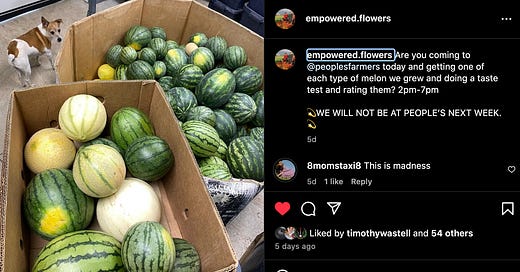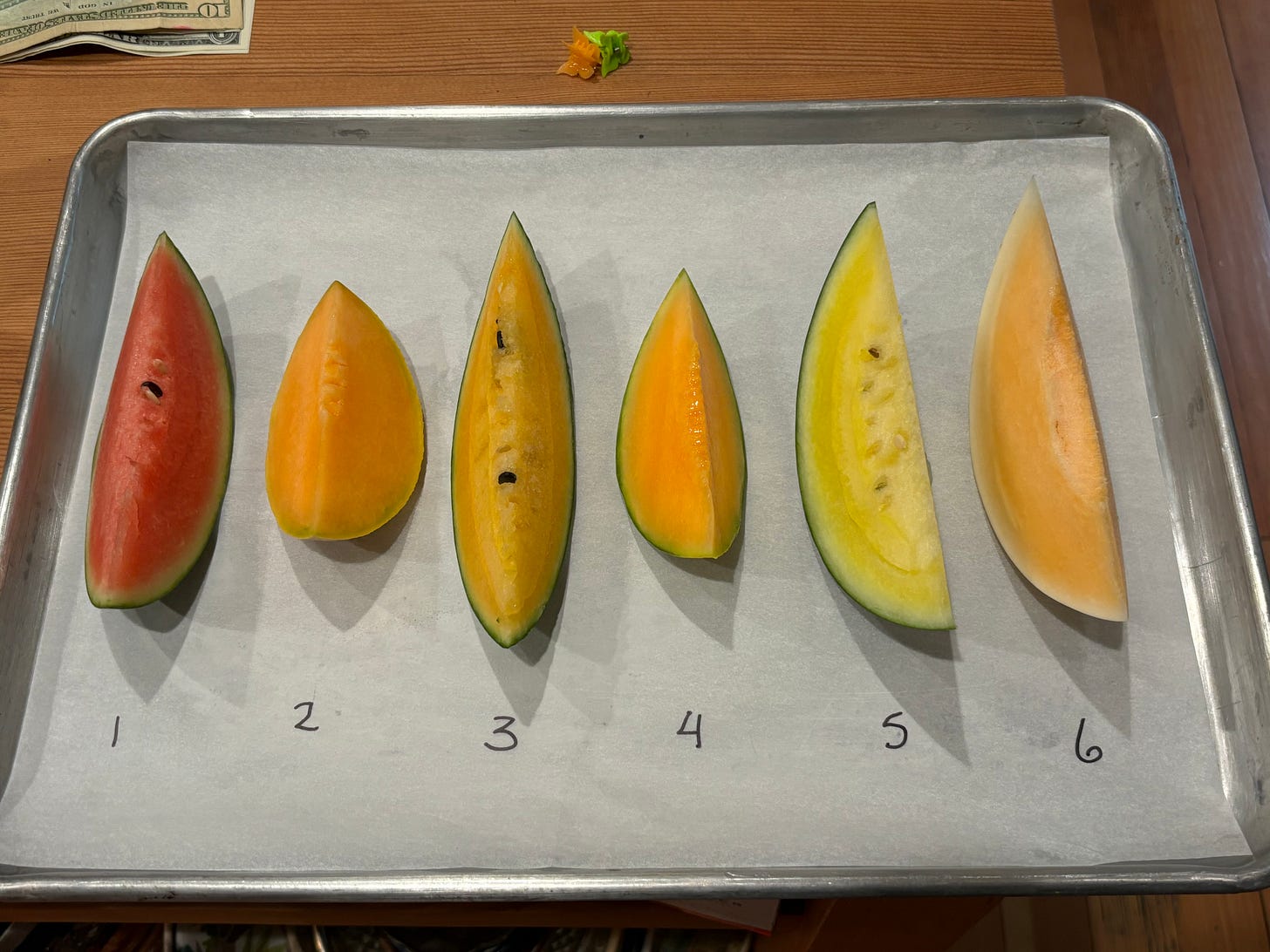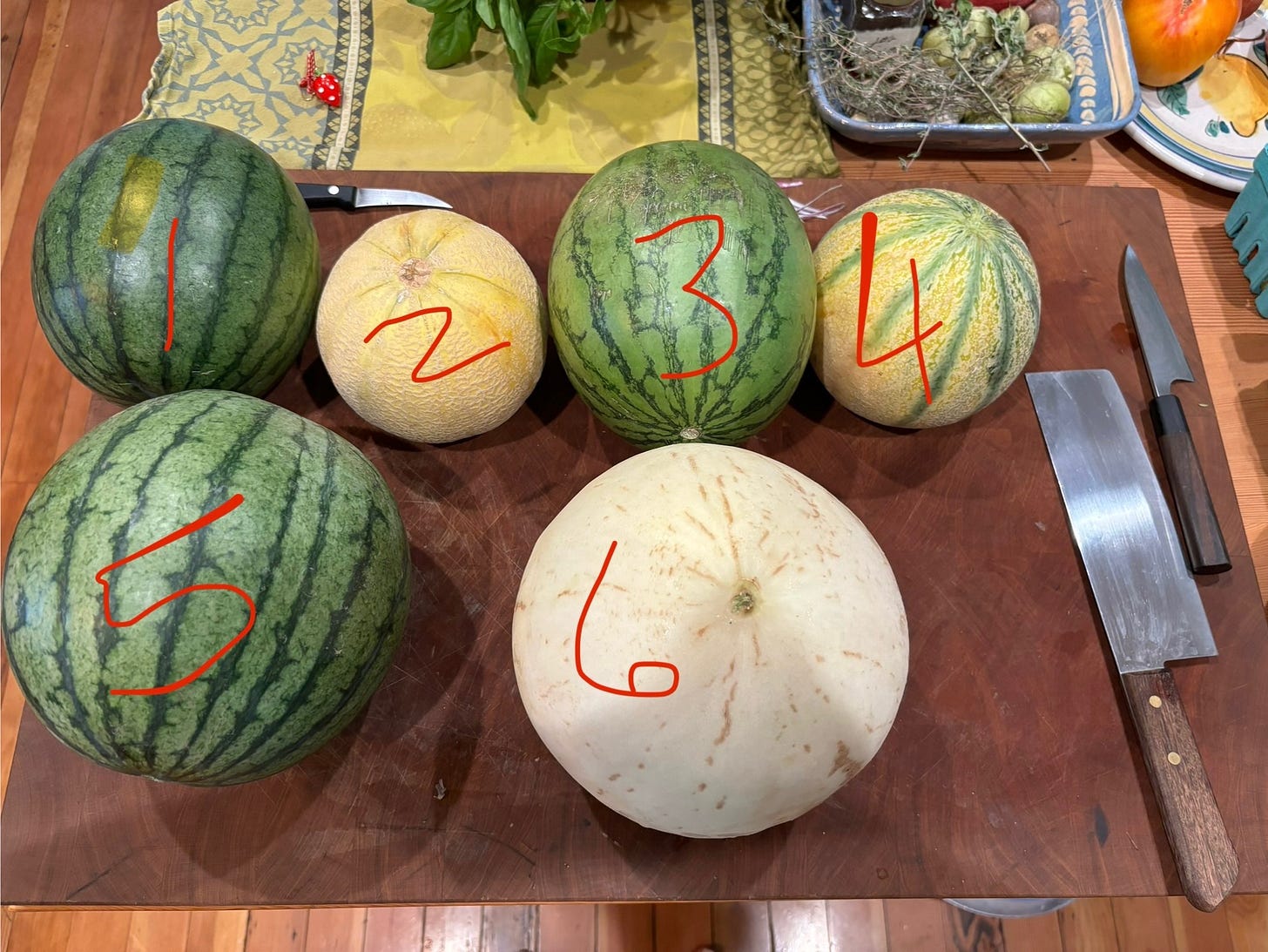This week, farmers Adrianna & Jolene at Empowered Flowers farm tasked us with an assignment:
Empowered Flowers grew over TEN different varieties of melons this season, and have been spotted padding friends’ booths at different farmers markets around the city with their abundance. When melons come on, they come on strong and all at once. It would appear that Empowered Flowers is richer than ever with their stunning crop this year. I give thanks to Adrianna, Jolene, and their all-star team of passionate and intensely hardworking farm hands. Y’all help us to live lavishly.
Timothy Wastell, chef at Antica Terra and heavy melon lover, acquired the melons from the People’s Co-op Farmer’s Market last week so that we could conduct a tasting together. But upon inspection, Tim and I were unsure as to which was which. After numbering and then tasting through them, we took photographs and resolved to revisit their market booth for more information. I took a trip to the Woodstock Farmers Market yesterday to intercept Jolene at their booth. She and I stood in front of towers of crates of melons, peering into their skins to guess at types.
Jolene knew all of the varieties by heart (varieties are not sign posted at their market booth) and it was not long before she could grace me with their names, in addition to the original heirloom varieties which certain hybrids had been derived from. Any good farmer pays very close attention to the varietals they grow. If you ask, you will find that certain farmers grow the same varieties every year. As Jolene walked me through the melons, she made comments along the way regarding which varieties she’d like to grow again next year, and which she could do without.
In anticipation of the forthcoming Culinary Breeding Network Variety Showcase, I think it’s important to consider how seed breeders and farmers dictate what we eat. Varieties are cultivated with a myriad of growth factors in mind: soil type, disease resistance, flavor, texture, nutrient density, aesthetic appeal, climate resilience and so forth. There are varieties of produce out there which are better suited to our swiftly changing climate, and seed breeders do the work to ensure that these varieties have a seat at the table inside seed catalogues. Chefs and home cooks everywhere should share this passion for variety in the hopes of influencing one another to stimulate a biodiverse and resilient climate future.
~
So without further ado, here is a little tour through six of the juiciest, most fragrant melons of the moment. Thank you to our dear farmers <3
*Big thanks to Timothy Wastell who has been tasting cucurbits both for the Culinary Breeding Network and his own research for over a decade. His tasting notes have been incorporated into the reviews below, alongside my own.
MINI LOVE
a classic mini red watermelon, Mini Love is a crushable crowd pleaser. It sports a crisp structure with a crunchy and light sweetness. Not too juicy or dry, its glistening flesh stands up to the palate. It has a thin rind and a grounded salinity. Good for salad or snacking.
DARTANIAN
Dartanian is a bright skinned charentais cantaloupe with intensely perfumed interior flesh. The outer skin is bloomy like brie cheese while the inside smells of lilac and pumpkin. Its meat is velvety and dense with juice, making it a strong candidate for scooping. Think ice cream, or sorbet. To be eaten with a spoon.
NEW QUEEN
This is an orange watermelon with a medium, honeyed sweetness. Its juices pooled where our concave bite marks left room. It is a drinkable melon with a baggy structure, a dam about to break.
GRISELET
Griselet is a hybrid version derived from the heirloom charentais melon, “Petit Gris de Rennes.” It has striking green stripes channeling down its sides in sections. The flesh itself is vegetal and firm, maintaining a subtle flavor of dulse and ocean spray. It is a briny melon, perfect for savory application in salads.
SURENESS
This yellow — nay, chartreuse! — watermelon is as much of a feast for the eyes as it is for the palate. Its flesh reverberates that percolating late-summer sunshine. I simply could not steal my eyes from its glowing visage while eating it. It is a truly joyous melon, simply snacking on it by the slice. Its skin is a bit on the thicker side, making it a great candidate for pickled rinds. Eat Sureness off the rind with friends in the garden.
HONEY ORANGE
This moon-looking honeydew type, unlike its brothers, has orange flesh like a cantaloupe. But do not be fooled as its level of sweetness is in every way characteristic of other honeydew melons. The first flavor which came to mind upon tasting was cotton candy. As Jolene peered over my shoulder at my notes, she said, “cotton candy? that must have been a note for the Honey Orange honeydew” — and she was right. Its flavor is certainly one of honey, but the sweetness is so concentrated that it evokes caramelization. Think honey candy or creme brulée. It leaves sugar crystals behind on the lips.
~
Thanks for reading a little bit about melons today. Go to your local market this week and stock up! Making melon sorbet, melon jam, or pickled watermelon//watermelon rinds are all great ways of preserving this intensely short lived yet abundant moment in time.
thank you Empowered Flowers and thank you mother freaking Earth. Love you bitches.
x jo






